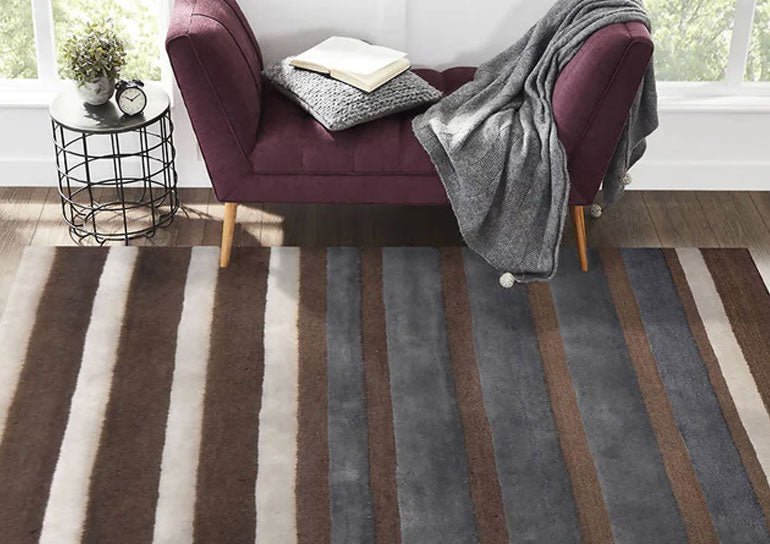From Waste to Wonderful: Upcycling in Rug and Carpet Design
Posted by VILLEDOMO INDIA

When it comes to sustainable living, upcycling has become a powerful tool for transforming waste into valuable treasures. This concept has gained significant traction in the world of rug and carpet design, where designers and artisans are pushing creative boundaries to breathe new life into discarded materials. In this blog post, we will delve into the fascinating world of upcycling in rug and carpet design, exploring the environmental impact of traditional manufacturing, the techniques used in upcycling, inspiring case studies, and the role of consumers in supporting this sustainable movement.
The Effects of Traditional Rug and Carpet Manufacturing on the Environment
Traditional methods for making rugs and carpets can have substantial environmental costs. The industry has made a considerable contribution to pollution and the depletion of resources, from the mining of raw materials through the energy-intensive manufacturing and disposal of trash. These problems are made worse by the excessive use of water, chemicals, and non-renewable resources. A ray of hope is provided by upcycling, which views garbage as a useful resource.
Upcycling is a creative process that involves repurposing discarded materials into new and functional products. In the realm of rug and carpet design, it opens doors to innovative possibilities. Designers have found inspiration in various waste materials, such as fabric scraps, plastic bottles, and discarded textiles. By transforming these materials, upcycled rugs and carpets not only reduce waste but also conserve resources that would have been used in traditional manufacturing processes. The beauty of upcycling lies in the fact that it turns what was once considered waste into a wonderful piece of art.
Upcycled Rug & Carpet Design Possibilities and Innovative Techniques
The market for recycled rugs and carpets is proof of human ingenuity. Discarded materials are combined using a variety of techniques to produce aesthetically appealing works. Some of the methods employed in recycled designs include patchwork, weaving, and tufting. For example, patchwork carpets utilize various fabric scraps to create unique patterns and textures. Cutting and sewing fabric scraps together with great care results in a beautiful mosaic of colors and textures. This method not only reduces waste but also gives the rugs a distinctive and lively personality.
Weaving techniques offer another avenue for upcycling. By incorporating diverse materials such as reclaimed yarn or shredded plastic, artisans can create rugs with interesting patterns and textures. The combination of different materials adds depth and visual interest to the final product, transforming discarded materials into works of art.
Tufting is a technique that repurposes discarded textiles by transforming them into soft, plush carpets. It involves creating loops with yarn or fabric and securing them to a backing material. This process not only gives a second life to old textiles but also results in cozy and luxurious carpets that add warmth and comfort to any space. The possibilities in an upcycled rug and carpet design are truly endless. From incorporating repurposed leather scraps into woven rugs to transforming discarded t-shirts into cozy shag carpets, designers continue to push boundaries and find new ways to create beautiful and sustainable floor coverings.
Creative Upcycled Rug & Carpet Projects
Let's look at some more motivational examples of upcycling in the carpet and rug industry:
These case studies show how upcycling may be used to make visually attractive and environmentally friendly rugs and carpets. These initiatives support a circular economy by giving new life to items that would otherwise be thrown away and encourage others to practice upcycling in their own homes.
The Role of Consumers in Supporting Upcycling
We can influence change and support sustainable practices as consumers. By choosing recycled carpets and rugs, we can actively support the circular economy and reduce trash. Consider looking into regional makers, fair trade groups, or online stores that sell repurposed goods while looking for home décor. By choosing upcycled designs, you support creative people who are committed to having a beneficial impact on the environment in addition to bringing a unique and eco-friendly piece into your house.
The journey from waste to wonderful is happening right within the rug and carpet industry through the power of upcycling. By reimagining and repurposing discarded materials, designers and artisans are creating sustainable and visually captivating rugs and carpets. This not only reduces waste but also conserves resources and contributes to a healthier planet. As consumers, we play a crucial role in supporting this sustainable movement. By choosing upcycled products, we can be part of the solution and inspire others to embrace the beauty of repurposed materials. Together, we can transform waste into wonderful creations that make a positive impact on our homes and the world around us.
It's amazing how upcycling in rug and carpet design can transform trash into priceless, useful, and long-lasting works of art. The sector is significantly moving in the direction of a greener future by experimenting with new methods, making use of leftover materials, and encouraging consumer support. We can actively back this movement and support a circular economy that appreciates both fashion and sustainability through the purchases we make as customers. Therefore, the next time you're looking for a rug or carpet for your home, take into account the amazing world of upcycling and add a distinctive, sustainable element to your living area.

